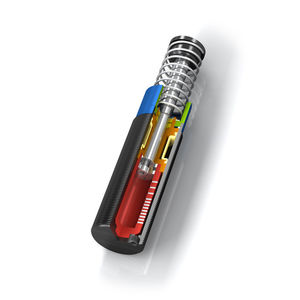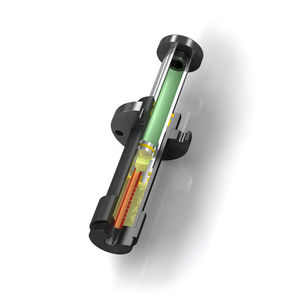
- Materials - Tools - Components
- Standard Mechanical Component
- Shock damper
- ACE Stoßdämpfer GmbH
- Company
- Products
- Catalogs
- News & Trends
- Exhibitions
Shock absorber EB63EUhydraulicsafetyfor heavy loads


Add to favorites
Compare this product
Characteristics
- Function
- shock
- Technology
- hydraulic
- Applications
- safety, for heavy loads
- Material
- steel
- Other characteristics
- piston, robust
- Load capacity
Max.: 80,000 N
Min.: 1,600 N
- Stroke
Max.: 800 mm
(31.5 in)Min.: 100 mm
(3.94 in)
Description
Low return force with spring assembly
Crane Installations, Optimized Characteristic
Reduced return forces: The ACE safety shock absorbers from the EB-Family offer internal system seals, large sized piston rod bearings and the maximum energy absorption for emergency stop applications. However, an integrated spring package in the robust shock absorber body makes sure that the return forces are reduced much to a fraction of those in the CB-Family.
The characteristic curve or damping characteristics of the maintenance-free and ready-to-install EB models is individually adjusted specific to the customer and to the respective application, just like all ACE safety shock absorbers.
These safety shock absorbers reliably perform their services in crane systems and in numerous heavy duty applications, even if the power fails, because these hydraulic machine elements are autonomous braking systems.
Impact velocity range 0.5 m/s to 4.6 m/s. Other speeds on request.
Reacting Force at max. capacity rating = 187 kN max.
Operating temperature range -12 °C to +66 °C. Other temperatures on request.
Mounting in any position
Positive stop Integrated
Material Outer body, Rod end button: steel corrosion-resistant coating; Piston tube: hard chrome plated steel
Damping medium Automatic Transmission Fluid (ATF)
Filling pressure approx. 0.55 bar to 1.1 bar. Rod return by integrated nitogen accumulator combined with additional return spring.
Catalogs
Main Catalog 2018
294 Pages
Related Searches
- Machine foot
- ACE anti-vibration mount
- ACE shock damper
- ACE hydraulic damper
- ACE mechanical damper
- ACE metal anti-vibration mount
- Metal foot
- Leveling foot
- ACE metal damper
- ACE industrial damper
- ACE rubber anti-vibration mount
- Elastomer foot
- ACE machine damper
- ACE plastic damper
- ACE vibration damper
- ACE gas spring
- ACE cylindrical anti-vibration mount
- ACE piston damper
- ACE adjustable damper
- ACE steel damper
*Prices are pre-tax. They exclude delivery charges and customs duties and do not include additional charges for installation or activation options. Prices are indicative only and may vary by country, with changes to the cost of raw materials and exchange rates.





